Trip Report : Star Air leading the Regional Air Connectivity with the Newly Inducted Embraer E175LR
Utkarsh Thakkar
07 Jul 2023
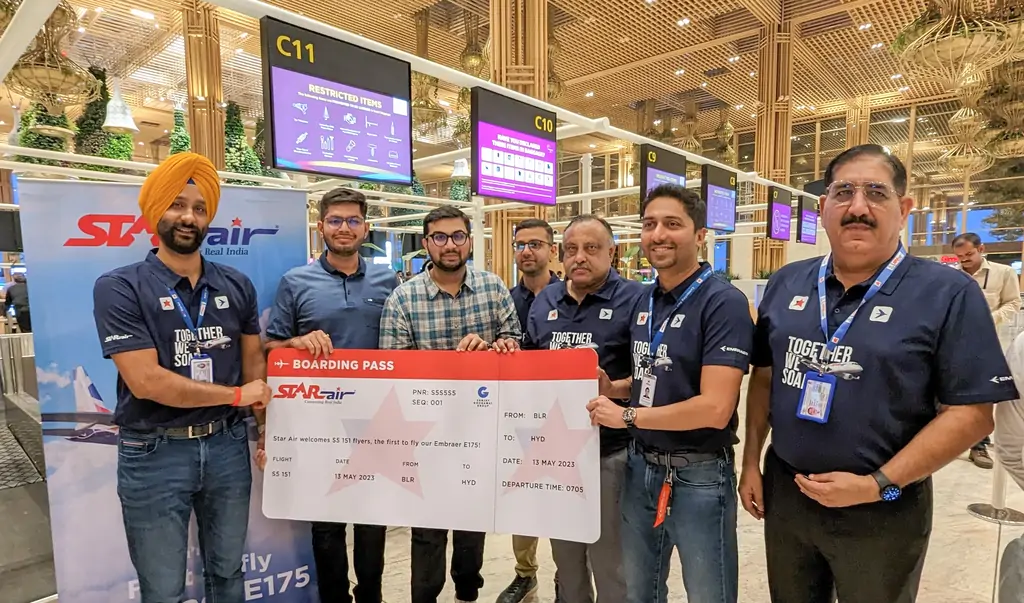
As a seasoned traveler, I have had the privilege of experiencing numerous airlines, but none have left me as consistently impressed and satisfied as this one. The attention to detail, impeccable service, and unwavering commitment to passenger comfort were apparent in every aspect of my journey. From the warm and welcoming smiles of the flight attendants to the state-of-the-art amenities and the seamless flight operations, Star Air surpassed all my expectations.
Check-in
All Star Air flights operate from Bangalore Airport Terminal 2, also known as Garden Terminal. Since it was an early morning flight, there was no rush at the airport, and I stayed near Bangalore Airport. The Star Air counters were decorated in the brand's colors to celebrate the first flight. The CEO of Star Air, Simran Singh Tiwana, and other officials from Star Air and Embraer, were present for the occasion. We headed straight to our gate after the lamp lighting and cake cutting. The airport felt like a shopping mall after passing through the security area and heading toward the gates. Due to the celebration at the counters, I couldn't visit the Bangalore Airport Terminal 2 lounge. Currently, the airport has limited options for food.
Boarding Gate
For today's flight, we had a bus boarding gate. Global Aviation handles Star Air's ground operations at Bangalore and Hyderabad Airport.
Aircraft
Star Air expanded its fleet by adding two Embraer E175LR aircraft. During the Farnborough Air Show last year, Star Air signed a Letter of Intent (LOI) with Nordic Aviation Capital for two E175LRs. In December 2022, they finalized the agreement for an additional two aircraft.
In February this year, Star Air took delivery of its first E175LR, which landed at Bengaluru airport. Following that, in May, Star Air successfully completed its proving flight as S5-170 from Bengaluru to Hyderabad airport. Then, on May 13, 2023, they commenced their first revenue flight with the E175LR aircraft.
Seating
The E175LR has a seating capacity of 76 passengers in a two-class configuration. Economy class has 64 seats, while business class has 12 seats. It's worth mentioning that Star Air is the only regional airline in India that provides a business class cabin, complete with delectable hot meals and a spacious 1x2 seating arrangement with a luxurious 36" seat pitch.
During my first flight on the E175LR, I was seated in economy class and was pleasantly surprised by the comfort of the seats, which featured a generous pitch of 31 inches. For aviation enthusiasts, I suggest selecting a seat located behind the wings for the perfect opportunity to capture stunning wingtip shots.
Crew and Service
The crew was friendly and continuously checked on the passengers from start to end. Although the sector was short, the crew members did their best to ensure a comfortable experience. Overall, I have always found Star Air's crew members to be friendly and warm, and treat passengers like family. The menu had a decent selection, and I highly recommend trying their cookies—they are a must-try! However, they don't offer pre-booked sandwiches onboard. We covered the distance from Bengaluru to Hyderabad in almost 45 minutes, and the experience was incredibly comfortable and enjoyable. I didn't want to leave the aircraft. Although I didn't get a chance to experience the business class this time, based on my economy class experience, I can only imagine how much more luxurious the journey would be in their business class cabin.
After Landing
It was the first commercial flight of the E175 at Hyderabad airport, but we didn't receive a water cannon salute. Our aircraft was parked at a remote bay, so we had to travel by bus to the terminal. Thanks to the bus boarding/deboarding process, I took more pictures of this beautiful aircraft. I believe all aviation enthusiasts will appreciate bus boarding.
Overall, Star Air's E175LR aircraft has revolutionized regional air travel, and I wholeheartedly recommend flying with them for a truly unique and memorable experience. I extend my sincerest gratitude to Star Air for providing an unforgettable flight that will forever hold a special place in my memory. I hope to soon see Star Air's E175 on most of their routes at my home airport.
About Star Air
Star Air is a regional carrier owned by the Sanjay Ghodawat Group, based in Kolhapur, Maharashtra. Star Air's headquarters is located in Bangalore.
Read next
VietJet has officially introduced a direct route between Ho Chi Minh City (Vietnam) and Kochi (India) which will start flying on August 12, 2023. The first-ever direct route from Kerala to Vietnam marks an important milestone for the development of Kochi airport and the tourism industry of the two countries. VietJet will now be operating a total of 32 flights a week between India and Vietnam. It is expected to further promote tourism, economic and trade cooperation, and the development of bilateral relations between Vietnam and India.
Furthermore, VietJet expands its fleet to meet growing travel demand: Receives 6th A330 and Adds 3 A321 neo-ACF Aircraft in May 2023. The new additions prioritize fuel savings, emission reduction, and environmental protection. These modern aircraft will replace older ones, enhancing operational efficiency, and cost savings, and delivering exceptional flight experiences to passengers at affordable fares.
In its strategic plan to expand connectivity between India with Vietnam, the Kochi – HCMC route will be operated with a frequency of 4 flights/week every Monday, Wednesday, Friday, and Saturday. The flights from Kochi will depart at 23:50 (local time) and land in Ho Chi Minh City at 06:40 (local time). The return flights will depart from Ho Chi Minh City at 19:20 (local time) and arrive in Kochi at 22:50 (local time). Additionally, Indians can fly to Vietnam on VietJet flights from Mumbai, New Delhi, and Ahmedabad to Hanoi and Ho Chi Minh City.
In the first five months of 2023, India has 141 thousand visitors to Vietnam, which is expected to reach 500,000 visitors annually. Previously, in 2022, the number of Indian visitors to Vietnam grew impressively, reaching 137,900 arrivals, ranking 9th in the 10 markets sending tourists to Vietnam the most. VietJet's new route is expected to bring about 10,000 more passengers from the southern region of India to Vietnam in 2023.
Officials' Comments
Speaking at the event, Vietnamese Ambassador to India, Nguyen Thanh Hai said, “The opening of the route connecting Kochi and Ho Chi Minh City by VieJjet is a breakthrough, creating a new impetus for economic - trade - tourism cooperation and people-to-people exchanges between Viet Nam and South India. With the favourable geographical location of Ho Chi Minh City in particular, and Viet Nam in general, visitors will easily explore destinations across Viet Nam as well as from Viet Nam to other countries and regions around the world. Congratulate VietJet, the airline operating the most air routes between our two countries, on pioneering in connecting the Indian Tier 2 cities with Viet Nam.”
"We are very happy to announce a direct flight service from Kochi airport to Ho Chi Minh City," said S Suhas, Managing Director, Cochin International Airport Limited (CIAL), "We are confident that the launch of this new air route between Kerala and Vietnam from CIAL will be a significant milestone in the tourism industry, providing travellers with a convenient and direct transportation option to meet their requirements. Also, the opening of a new air route marks a pivotal moment in the history of airport operations, which will help our company in opening up new avenues for economic growth and cultural exchange", he added.
Speaking at the event, Jay L Lingeswara, Vice President of Commerce, VietJet said, “With this new route, VietJet will fundamentally increase connectivity between Vietnam and India. We expect that VietJet will significantly contribute to the tourism growth of Kerala, India and Vietnam via its wide range of products and services accompanied by competitive and reasonable fares.”
About the Airline
VietJet is a Vietnamese low-cost airline based in Hanoi. It was the first privately-owned new-age airline to be established in Vietnam, being granted its initial approval to operate by the Vietnamese Minister of Finance in November 2007. As of its launch in December 2011, it became the second private airline to offer domestic service in Vietnam, as well as the fifth airline overall to offer civil domestic flights. VietJet Air is owned by Sovico Holdings, HDBank, other organisational investors, and individual stakeholders. The carrier's launch was beset by long delays attributed to various causes, such as a global economic slowdown and regulatory issues. Despite the setbacks, VietJet Air's first flight was operated on 25 December 2011, flying from Ho Chi Minh City to Hanoi. The carrier carried its 10 millionth passengers in December 2014, and its 25 millionth passengers in December 2015. The carrier began operations initially with 3 A320 aircraft to Ho Chi Minh City and Da Nang. VietJet had planned to utilise the AirAsia brand after receiving an investment from the Malaysian LCC but went ahead with the VietJet brand after AirAsia was denied regulatory approvals.
Read next
The Indian government has created an additional 1,222 new posts in the Directorate General of Civil Aviation (DGCA), Airports Authority of India (AAI), and Airports Economic Regulatory Authority (AERA). To beat the shortage of air traffic control officers (ATCOs), the Union Aviation Ministry has created 796 positions since July 2021. For the aviation safety regulator and AERA, the government created a total of 416 and 10 new positions, respectively.
The domestic aviation industry continues to witness a recovery, with air passenger traffic logging around 60% growth at 13.60 crore passengers in FY23 annually. The Indian carriers had flown a total of 8.52 crore passengers on local routes in the year ended March 2022, as per ICRA. In FY23, the overall airlines' capacity deployment was higher by 38% as compared to FY22.
Hiring Soars After Mega Aircraft Deals
The mega aircraft deal where Air India placed an order for 470 passenger planes worth USD 80-100 billion from Airbus and Boeing, is expected to open up numerous jobs for pilots, cabin crew and engineers. Moreover, other Indian airlines such as IndiGo, Akasa Air, Vistara, and Go Air together have around 1,100 planes on order — which means the aviation market and allied sectors will have several job openings shortly.
IndiGo has also announced a 500-aircraft deal with Airbus, a record in aviation history. The agreement has topped the 470-aircraft deal recently signed by Air India and sparks a race to capitalise on India’s growing base of fliers and vast expat population. The deal was signed on June 19 at the Paris Air Show in the presence of Chairman of the Board of IndiGo V Sumantran, CEO of IndiGo Pieter Elbers, CEO of Airbus Guillaume Faury, and, Airbus' Chief Commercial Officer and Head of International Christian Scherer.
The order for 500 A320 Family aircraft sets the "record for the biggest single purchase agreement in the history of commercial aviation," Airbus said in a statement. With its fleet of over 300 aircraft, IndiGo is currently operating over 1.800 flights a day and connects 78 domestic destinations and over 20 international destinations. It also has orders that are yet to be delivered, taking up the current strength of its fleet to 480.
Akasa Air, founded by late billionaire Rakesh Jhunjhunwala, Vinay Dube and Aditya Ghosh has announced expansion of its fleet after it placed an order for another four Boeing 737 Max aircraft at the ongoing Paris Air Show. The airline which currently operates a fleet of 19 737 Max aircraft had placed an order for 72 aircraft before it started operations in August last year. The new order for additional aircraft is a follow-up order which will take its fleet size to 76 aircraft over the next four years with the inclusion of 53 high-capacity 737-8-200 aircraft apart from 23 737-8s.
In 2022, the Ministry of Civil Aviation said in the Lok Sabha that the Indian aviation industry will likely give employment to 1,00,000 people by 2024. The Directorate General of Civil Aviation (DGCA) reported that after the Covid-19 crisis in 2020 and 2021, aviation passenger traffic in India grew by 47% to 123.2 million passengers in 2022.
Directorate General of Civil Aviation (DGCA)
DGCA serves as the aviation safety regulator, responsible for regulating air transport services to, from, and within India. The DGCA is entrusted with enforcing civil air regulations, maintaining air safety and airworthiness standards, as well as overseeing the licensing and training of aviation personnel. It became a statutory body under the Aircraft (Amendment) Act, of 2020. The Government of India is planning to replace the organisation with a Civil Aviation Authority (CAA), modelled on the lines of the American Federal Aviation Administration (FAA). The CAA has been envisaged as an autonomous regulatory body which will replace the DGCA and will meet standards set by the UN's International Civil Aviation Organization (ICAO). The CAA will have separate departments to deal with safety, economic regulation and grievance resolution, as well as a full-fledged environment department. It will also have an independent accident investigation bureau. The Authority will also have the autonomy to recruit staff. Currently, the DGCA is understaffed and does not have any recruitment powers. The CAA will have administrative and financial powers similar to those of the American FAA. These powers will redefine the regulator's role and better equip it to face the challenges of the growing Aviation sector in the country. Employees working with DGCA will be transferred to the CAA.
Airports Authority of India (AAI)
The AAI is a statutory authority responsible for the management, development, and operation of airports throughout the country. It plays a vital role in the infrastructure development of airports across India and is the sole provider of air navigation services, which is a sovereign function entrusted to AAI. AAI currently manages a total of 137 airports, including 34 international airports, 10 Customs Airports, 81 domestic airports, and 23 Civil enclaves at Defence airfields. AAI also has ground installations at all airports and 25 other locations to ensure the safety of aircraft operations. AAI covers all major air routes over the Indian landmass via 29 Radar installations at 11 locations along with 700 VOR/DVOR installations co-located with Distance Measuring Equipment (DME). 52 runways are provided with Instrument landing system (ILS) installations with Night Landing Facilities at most of these airports and an Automatic Message Switching System at 15 Airports. The department deals with providing various facilities for the passengers such as Retail, F&B, Duty-Free, Money Exchange, Car Rental, Vehicle Parking etc.
Airports Economic Regulatory Authority (AERA)
The AERA is an independent regulatory body tasked with overseeing the economic regulation of airports in India. Its main objectives include creating a level playing field, fostering healthy competition among major airports, promoting investment in airport facilities, and regulating tariffs for aeronautical services. Traditionally, most of the Airports in India were under the ownership and control of the Government of India. In 1997, the Government of India formulated Airport Infrastructure Policy, which provided for the private sector’s participation in improving quality, efficiency and increasing competition. As a result of this initiative, Greenfield airports in Public-Private Partnership came up in Bangalore and Hyderabad. This trend indicated growing competition and a requirement for a level playing field amongst different categories of airports in future. The Airports Authority of India then performed the role of airport operator as well as regulator, which resulted in a conflict of interest.
Thereafter the Government of India set up Naresh Chandra Committee to prepare the road map for the civil aviation sector. The Committee recommended for setting up of an independent regulatory authority. To implement the recommendations of the Committee it was felt that an independent economic regulator may be established. Accordingly, the Airports Economic Regulatory Authority Bill, 2007 was passed by the Parliament in 2008 and received assent from the President on December 5, 2008. The Airports Economic Regulatory Authority Act, 2008 (27 of 2008) came into effect on January 1, 2009, except Chapter III and Chapter VI of the AERA Act, 2008 which came into effect on September 1, 2009. By the AERA Act, 2008 the Central Government established the Airports Economic Regulatory Authority of India to regulate tariffs and other charges for aeronautical services rendered at airports.
(With Inputs from CNBC TV18)
Read next
Akasa Air Claims No Cabin Crew Resignation; Expects 3500 Employees by 2023 End
Radhika Bansal
07 Jul 2023
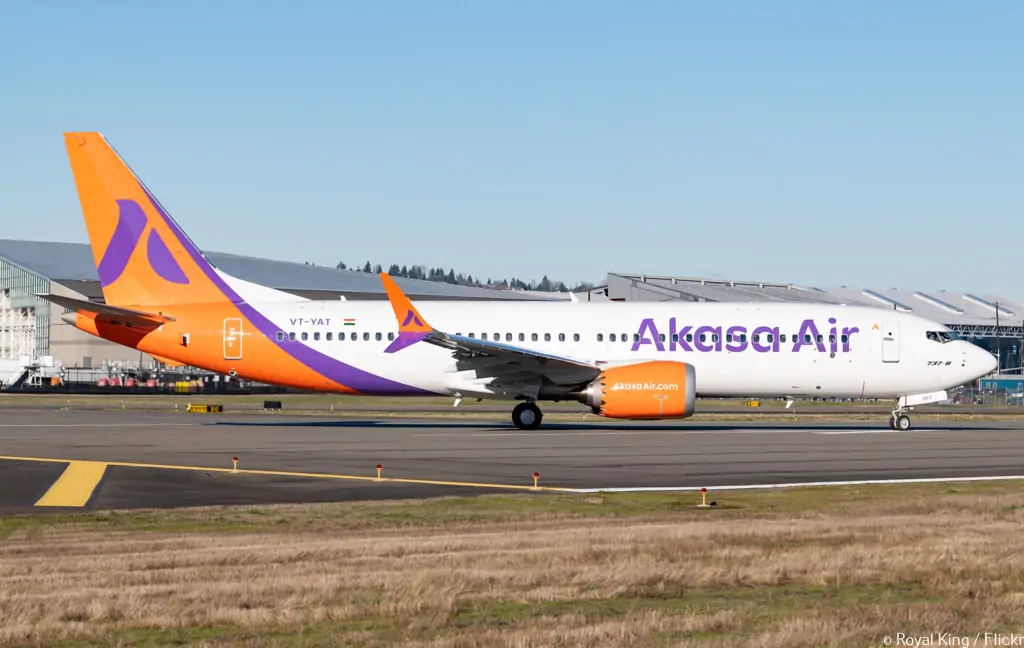
Akasa Air has one of the lowest attrition rates in the industry and expects to have around 3,500 employees by the end of this year, amid reports that scores of cabin crew have put in their papers. Earlier in March, Akasa Air reportedly had said it was planning to take staff strength by another 1,000 employees by March 2024.
Currently, the carrier, which started flying in August last year, operates more than 900 flights every week. It also plans to start international operations by the end of 2023. Akasa Air carried 6.29 lakh passengers in May, and the domestic market share stood at 4.8%.
"At Akasa, we have one of the lowest attrition rates and the fastest-growing network in the industry. Today, we have 3,000 employees and expect to grow to approximately 3,500 employees in 2023," it said in the statement. Akasa Air, the newest entrant in the world's fastest-growing aviation market and backed by late ace investor Rakesh Jhunjhunwala, said in a statement that it was on course to announce another significant three-digit aircraft order by the end of 2023. It expects to have a total of 72 aircraft by March 2027.
The airline, which currently has 19 planes, expects to have a total of 72 aircraft by March 2027. Last month, the airline announced it will acquire four more Boeing 737 Max planes and said it was looking at a three-digit aircraft order by the end of this year. "The speculation on cabin crew resignations at Akasa is factually incorrect and baseless as is the statement on the reduction of capacity. In fact, the reality is quite the opposite," the carrier said on Thursday.
No Cabin Crew Resignation
Vinay Dube, founder and CEO at Akasa Air, denied reports about the airline facing cabin crew resignations and said that the airline has "one of the lowest attrition rates" in the industry. The statement came in denial of reports on social media that some 200 cabin crew have flown out from Akasa Air to other domestic carriers. Rumours are also doing rounds that Akasa was looking to trim its flight network by withdrawing from certain routes, which it is operating at present.
He said that the budget carrier expects to grow to 3,500 employees by 2023-end as compared to 3,000 employees at the moment. "Today, we have 3,000 employees and expect to grow to approximately 3,500 employees in 2023. We operate over 900 flights per week across our network and are on track with our plans to start international operations by the end of this year," said Dube.
Akasa Air to Raise USD 75-100 Million
Akasa Air is looking to raise USD 75-100 million by offering fresh shares to expand its business, a report has said. The airline, founded in December 2021, wants the money to make pre-delivery payments for aircraft, the Economic Times quoted sources as saying. The Mumbai-based airline ordered 72 Boeing 737 Max, of which 19 have been delivered. The move to raise funds will dilute the Jhunjhunwala family’s 46% stake in the airline. The family holds this stake through a trust and despite the potential dilution, it will remain the largest shareholder.
The airline, which commenced operations less than a year ago, has reached out to potential investors, including PE firms and high-net-worth individuals, for raising capital. Any infusion of capital will be based on a USD 650-million valuation. US-based hedge fund PAR Capital Management is one of the names doing the rounds and may subscribe to the shares to add to its existing 6% stake in the low-cost airline. Brokerage firm ICICI Securities said on June 12 the outlook for airlines remained strong due to healthy traffic growth, declining jet fuel prices and ticking ticket values.
As per the report, the airline initially received a startup capital injection of USD 50 million from the Jhunjhunwala family, and with additional gains from aircraft sale and leaseback arrangements, the venture secured a capital base of USD 300-350 million, enabling its successful launch.
Read next
Flying through the skies at thousands of feet above the ground, airplanes encounter various atmospheric conditions. Turbulence refers to the irregular and unpredictable flow of air that can cause aircraft to experience sudden jolts, bumps, or shaking. While turbulence can occur for several reasons, there are specific factors contributing to the increasing bumpiness of airline flights in recent times.
Understanding Turbulence
Before delving into the causes of increased turbulence, it is essential to understand the different types of turbulence. There are three primary types: thermal turbulence, mechanical turbulence, and shear turbulence. Thermal turbulence is caused by temperature differences in the atmosphere; mechanical turbulence is generated by the interaction of airflow with the earth's surface; and shear turbulence arises due to abrupt changes in wind speed or direction.
Turbulence Intensity Classification | |
Intensity | EFFECT |
Light | Slight erratic changes in altitude and/or attitude |
Moderate | Change in altitude and/or attitude, but the aircraft remains in positive control at all times |
Severe | Large, abrupt changes in altitude and/or attitude. Aircraft may be momentarily out of control |
Extreme | Aircraft is violently tossed about and practically impossible to control. May cause structural damage. |
Climate Change and Turbulence
One of the significant factors influencing the bumpiness of airline flights is climate change. As global temperatures rise, the atmosphere becomes more unstable, leading to increased turbulence. Warmer air can hold more moisture, which contributes to the formation of thunderstorms and severe weather conditions. These weather patterns are often associated with turbulent areas that aircraft must navigate through, resulting in bumpier flights.
According to a Washington Post analysis, the phenomenon known as wind shear (the degree to which winds fluctuate at various altitudes) has increased by roughly 15% since 1979. High wind shear causes variations in air pressure and wind speed at different altitudes. It has a ripple effect on the movement of aircraft, increasing the risk and frequency of turbulence. Typically, aircraft encounter turbulence while traversing through or near a cloud, and pilots are advised to avoid clouds. However, global warming is causing more "clear skies" air turbulence, according to the Washington Post. Airlines expect and forecast cloud and weather-related turbulence, but clear-sky turbulence is impossible to predict, making it unexpected and naturally more dangerous.
Jet Streams and Their Impact
Jet streams, high-altitude narrow bands of fast-flowing air, also play a role in the bumpiness experienced during flights. These strong winds can reach speeds of over 200 miles per hour and are influenced by the temperature differences between tropical and polar air masses. Pilots try to utilize jet streams for faster travel; however, flying near them can lead to encounters with turbulence.
Paul Williams and his colleagues at the University of Reading in England discovered that turbulence in the North Atlantic jet stream increased in frequency by 17 to 55 percent between 1979 and 2020 by poring over historical flight and meteorological data. The most significant increase was for the most severe type of turbulence, characterized as having a g-force greater than 1g. Anything not anchored to the plane, including your stomach, will float for a brief instant when the turbulence forces the jet to speed downhill faster than gravity. If you are not belted up, you will be thrown out of your seat when the jet plummets a few tens of meters.
Air Traffic and Congestion
The increasing volume of air traffic is another contributing factor to the bumpiness of airline flights. Airports worldwide are handling a growing number of flights each year, resulting in congestion in the skies. With more aircraft sharing the same airspace, it becomes challenging for pilots to avoid areas of turbulence, leading to a higher likelihood of encountering rough patches during flights.
Advancements in Weather Forecasting
While climate change and air traffic contribute to the overall increase in turbulence, advancements in weather forecasting have improved our ability to predict and avoid turbulent areas. Modern technology enables meteorologists to track atmospheric conditions more accurately, allowing pilots to receive real-time weather updates and adjust flight paths accordingly. Despite these advancements, avoiding turbulence entirely remains a challenge.
Impact on Passengers and Crew
Bumpier flights can have an impact on both passengers and the flight crew. For passengers, experiencing turbulence can be unsettling and lead to feelings of discomfort or anxiety. It is crucial to note that turbulence rarely poses a threat to the structural integrity of the aircraft. However, it can still cause minor injuries if passengers are not securely fastened with their seatbelts. For the flight crew, dealing with increased turbulence means having to navigate through challenging conditions while ensuring the safety and well-being of passengers. Pilots must make real-time adjustments to their flight paths, following the guidance of air traffic control and weather updates, to minimize the impact of turbulence.
Strategies to Cope with Turbulence
To cope with turbulence, airlines and aircraft manufacturers have implemented various strategies. These include:
Improved Seat Designs: Airlines have introduced advanced seat designs that can absorb vibrations and reduce the impact of turbulence on passengers.
Seatbelt Usage: Passengers are encouraged to keep their seatbelts fastened throughout the flight, even when the seatbelt sign is turned off. This helps ensure their safety during unexpected turbulence.
Pilot Training: Pilots undergo extensive training to handle different weather conditions and turbulence. They are equipped with the knowledge and skills to navigate through turbulent areas safely.
Weather Monitoring: Airlines have access to sophisticated weather monitoring systems that provide real-time updates on weather conditions, allowing them to make informed decisions regarding flight paths and potential turbulence areas.
Technology Advances to Mitigate Turbulence
To address the challenges posed by increased turbulence, the aviation industry has made significant advancements in technology. These advancements aim to enhance the safety and comfort of passengers and crew during bumpy flights. One such technology is the development of advanced weather radar systems. These systems enable pilots to detect and avoid turbulent areas by providing real-time weather information. By having a clear picture of the weather conditions ahead, pilots can make informed decisions to minimize turbulence encounters.
Additionally, aircraft manufacturers have been incorporating turbulence-detection sensors into their designs. These sensors can detect variations in air pressure and movement, allowing the aircraft's systems to adjust to minimize the impact of turbulence. This technology helps stabilize the flight and reducing the discomfort caused by sudden jolts. Furthermore, improved communication systems have been implemented to enhance coordination between air traffic controllers and pilots. This allows for more efficient routing and enables pilots to navigate around areas of known turbulence. By receiving timely updates and guidance, pilots can choose flight paths that avoid turbulent regions, providing a smoother journey for passengers.
Safety Measures on Airplanes
Airplanes are designed and built to withstand turbulence and ensure the safety of passengers and crew. Some of the safety measures in place include:
Strong Structure: Aircraft are built with sturdy materials and designed to withstand the forces exerted by turbulence.
Wing Flexibility: The wings of airplanes are designed to flex and absorb the impact of turbulence, reducing stress on the aircraft's structure.
Turbulence Detection Systems: Modern airplanes are equipped with turbulence detection systems that can alert pilots to areas of turbulence ahead, allowing them to take necessary precautions.
Emergency Equipment: Airplanes are equipped with emergency equipment, such as emergency exits, life vests, and oxygen masks, to ensure the safety of passengers during any unforeseen events.
Tips for Dealing with Turbulent Flights
While advancements in technology have made air travel safer, it is still essential to be prepared for turbulent flights. Here are some tips to help you cope with turbulence:
Stay Seated with your Seatbelt Fastened: Keeping your seatbelt fastened at all times, even when the seatbelt sign is off, is crucial. This ensures your safety during unexpected turbulence.
Follow Instructions from the Cabin Crew: The cabin crew is trained to handle turbulence situations. Listen to their instructions and follow any safety procedures they communicate.
Choose your Seat Wisely: Seats over the wings tend to experience less motion during turbulence. If you are particularly sensitive to turbulence, consider selecting a seat in this area of the aircraft.
Distract Yourself: Engage in activities that distract you from the turbulence, such as reading a book, listening to music, or watching an in-flight movie. Focusing on something other than the movement of the aircraft can help reduce anxiety.
Practice Deep Breathing and Relaxation Techniques: If you feel anxious during turbulence, practice deep breathing exercises or other relaxation techniques to help calm your mind and body.
Conclusion
In conclusion, airline flights are indeed getting bumpier, and several factors contribute to this phenomenon. Climate change, jet streams, increasing air traffic, and advancements in weather forecasting all play a role in the increased frequency and intensity of turbulence during flights. While airlines and aircraft manufacturers have implemented strategies to cope with turbulence and ensure passenger safety, it remains an inherent part of air travel. By staying informed, following safety instructions, and remaining calm, passengers can navigate bumpy flights more comfortably.
With Inputs from Scientific American, Live Mint, Weather.gov
Read next
Jet Airways Spent INR 470 crore Since Implementation of Corporate Insolvency Resolution Process
Radhika Bansal
07 Jul 2023
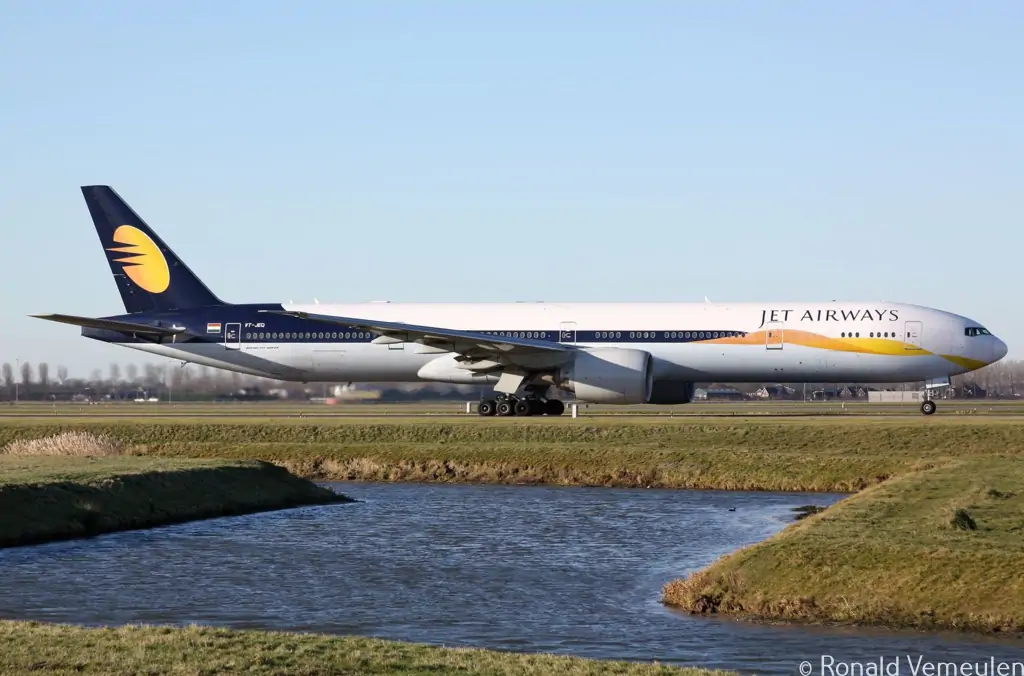
The Committee of Creditors (CoC) of grounded airline Jet Airways told the Supreme Court on July 5 that it has spent INR 470 crore since the implementation of the Corporate Insolvency Resolution Process (CIRP), without getting any return on investment. Represented by Additional Solicitor General Venkatraman, the CoC further told the court that they are incurring expenses to the tune of INR 23 crore per month. Jet Airways workmen association agreed with the CoC and informed the court that they have not been paid their dues as well.
The apex court was hearing a case by the Jet aircraft engineers maintenance welfare association against the company seeking recovery of their dues. The case was adjourned after the bench led by Chief Justice of India DY Chandrachud was informed that other cases about the recovery of dues from Jet Airways are pending before other benches of the apex court. The CJI directed that all the cases about Jet Airways be grouped and listed before his bench for hearing soon.
In May 2023, the National Company Law Appellate Tribunal (NCLAT) granted Jalan Kalrock Consortium, which emerged as a successful bidder to take over Jet Airways, more time to make payments to the State Bank of India (SBI).
The appellate tribunal has noted that despite National Company Law Tribunal (NCLT) having approved the resolution plan in January, the case came to be heard by the NCLAT in March and an order of refusal of stay was passed on March 3, hence the tribunal held that Jalan Kalrock is entitled to an exclusion from November 16, 2022, to March 3, 2023, for complying with payment obligation towards SBI.
Payment to Lenders
On January 13, the National Company Law Tribunal (NCLT) allowed the transfer of the beleaguered airline to the consortium led by London-based Kalrock Capital and UAE-based entrepreneur Murari Lal Jalan. It also asked the consortium to make payments by May 15, 150 days from the initiation of the ownership proceedings, but the NCLAT exemption gives it more time.
The consortium was to make the first tranche of the payment to Jet's lenders before May 15 but it didn't and feared that the SBI would invoke the performance bank guarantee of INR 150 crore instead of INR 175 crore worth of dues. Lenders of the airline had approached the NCLAT as they opposed the ownership transfer to the consortium. They alleged that the consortium had not fulfilled its obligations. Subsequently, the appellate tribunal granted an extra three months to the consortium to pay the dues to SBI.
Jet Airways was grounded in April 2019 over growing losses and a debt of about INR 8,000 crore. In October 2020, the airline's Committee of Creditors (CoC) approved the revival plan submitted by the Jalan-Kalrock consortium.
Revival Plans
Directorate General of Civil Aviation (DGCA) will only re-issue an air operator's certificate (AOC) to Jet Airways once it resolves disputes with lenders and provides proof of its financial capabilities, according to a report by Hindu Business Line. Jet Airways AOC lapsed in May. The report says the DCGA will only re-issue one if the airline can lock in senior management and reconstitute its board, resolve legal disputes, including those with lenders, and secure aircraft lease agreements. Since losing its AOC, Jet Airways has reportedly approached the DGCA seeking a new one.
Jet Airways ceased operations in April 2019 owing around INR 80 billion. In October 2020, a vote by the committee of creditors approved a bid by Murari Jalan and Florian Fritsch to buy the airline. The new owners planned an imminent restart, which was contingent on them paying creditors (including banks) around USD 0.10 on every dollar owed and pumping almost INR 10 billion into recapitalising Jet Airways over five years.
However, the agreement has since collapsed into a mire of recriminations and legal disputes, with the airline no closer to restarting. The saga has generated plenty of headlines in India but has recently been overshadowed by the Go First insolvency. That airline is also attempting to restart. But, as the DGCA points out, Go First's restart currently has the backing of lenders, while the Jet Airways restart does not.
A spokesperson for the Jalan Kalrock consortium says Jet Airways continues to engage with disgruntled lenders, seeking to settle disputes. In May, the consortium went back to the National Company Law Tribunal (NCLT) to prevent its most aggressive lender, the State Bank of India, from encashing an INR 1.5 billion bank guarantee after the consortium defaulted on its payment obligations. The tribunal gave Jet Airways' new owners until August to meet its commitment.
Ahead of that occurring and losing its AOC, a raft of senior Jet Airways' management, including the CEO, left the airline. To date, no new CEO has been appointed. There is also a report of a letter of intent signed with an unidentified United States-based lessor to acquire eight aircraft. However, that letter, which remains unverified, is only valid for three months.


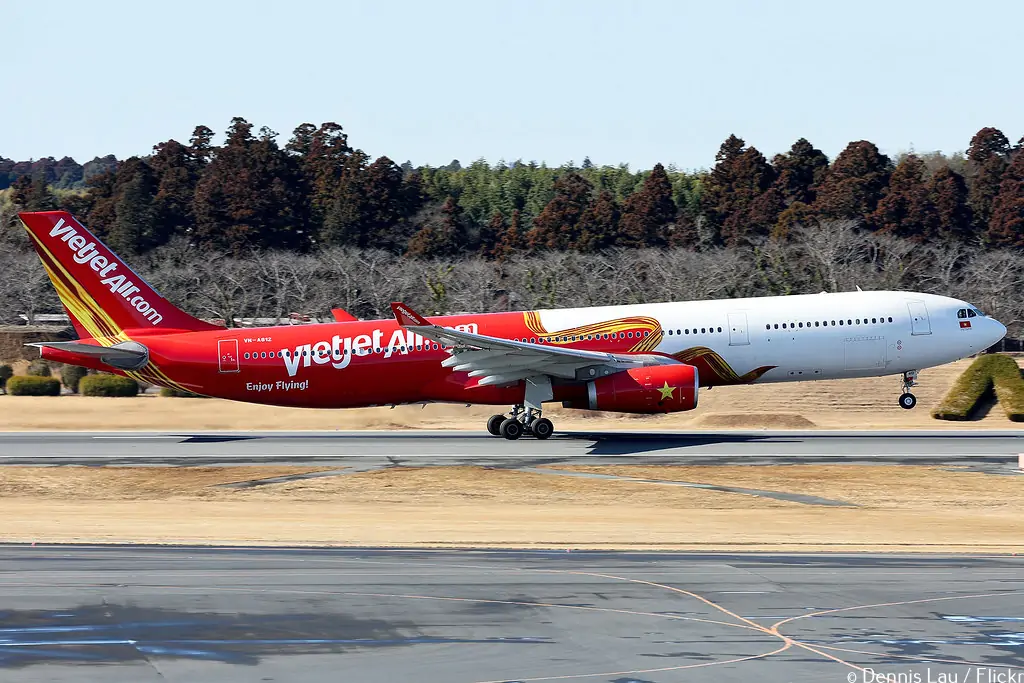
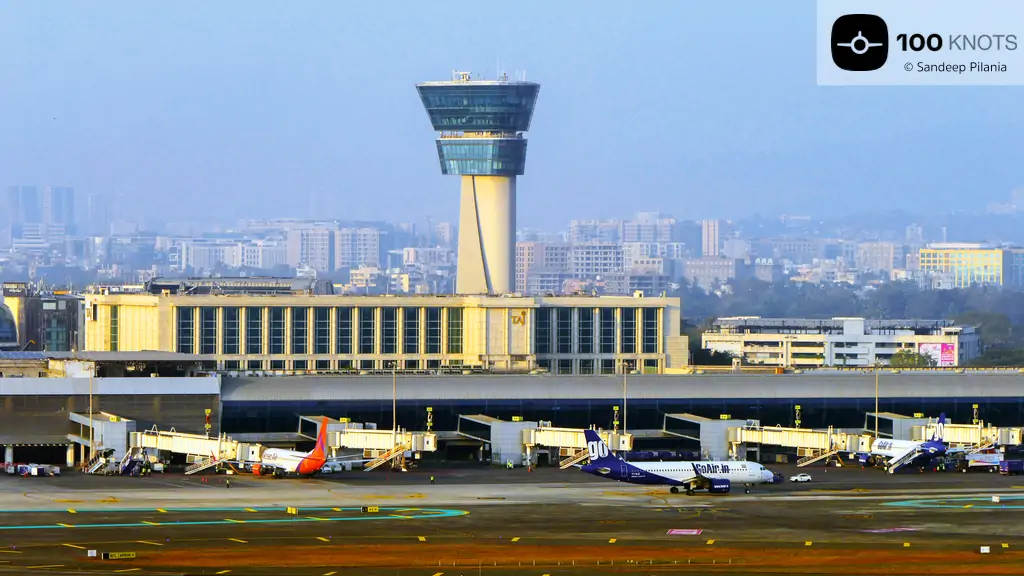

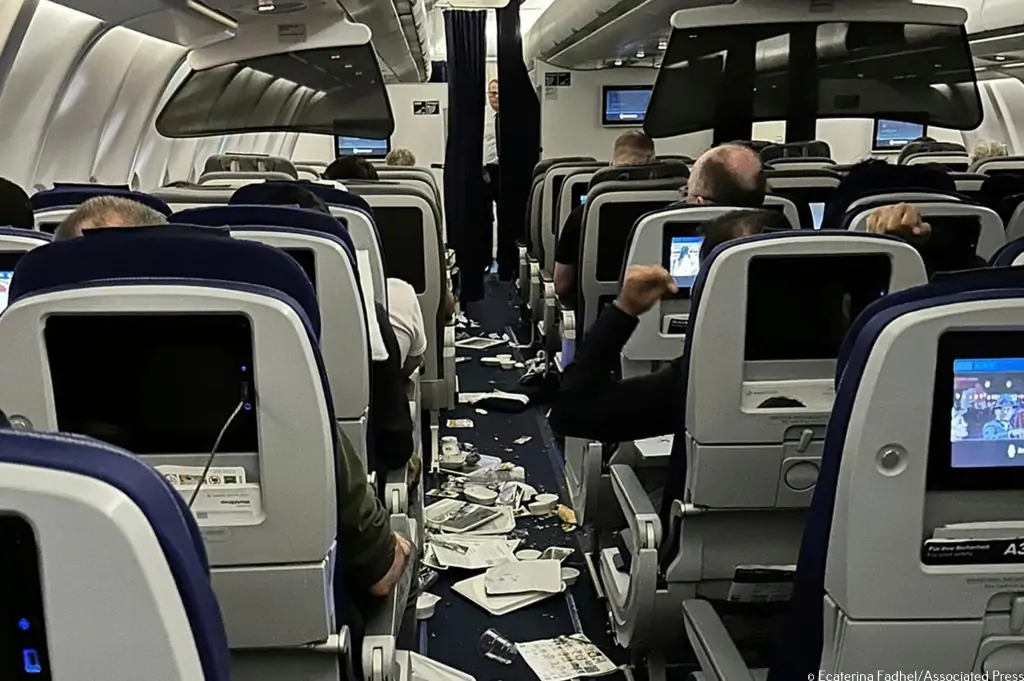
Comment